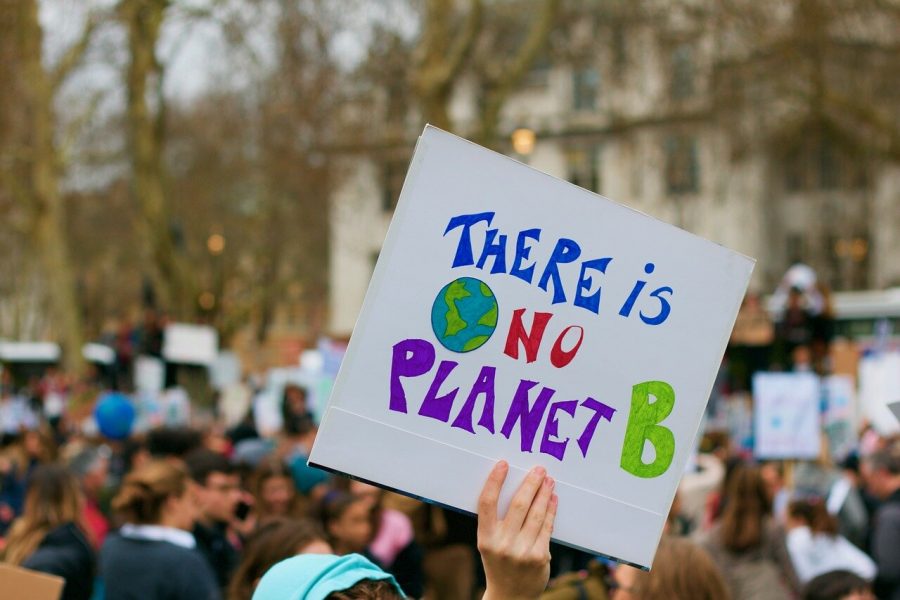Biden takes active stance on climate crisis in his first days in office
February 6, 2021
President Joseph R. Biden has signed 22 executive orders since taking office on Jan. 16, many of which differ and rollback policies from the previous administration.
Most notably, he is taking actions to combat climate change which the White House has declared “an emergency.” He made Jan. 27 a climate day at the White House and solely signed executive orders related to dealing with it.
On Jan. 14, Biden announced he would implement a $1.9 trillion “American Rescue Plan” to combat climate change. Though it focuses on handling COVID-19 and vaccinating, it has a large environmental component.
His new green deal is widely received as ambitious, with promises to completely clean electricity by 2035 and achieve net-zero emissions economy-wide by 2050.
On his first day in office, Biden fulfilled a campaign promise by signing an executive order to have the United States reenter the Paris Agreement. The agreement is a pact between countries in the United Nations to reduce carbon emissions in an effort to keep temperature increases below two degrees.
From that point onward, Biden established that climate change would be one of his top priorities, a stark shift in the nation’s previous stance of climate change being a hoax.
In one executive order, Biden wrote “the United States will also move quickly to build resilience, both at home and abroad, against the impacts of climate change that are already manifest and will continue to intensify according to current trajectories,” according to The White House official website. This solidifies that climate change will be dealt with domestically, as well as be incorporated into United States’ foreign policy.
In fact, Biden called U.S. allies like President Emmanuel Macron of France, U.K. Prime Minister Boris Johnson, Canadian Prime Minister Justin Trudeau and German Chancellor Angela Merkel to express just how integral climate change will be to United States policy going forward.
In that same executive order, he placed emphasis on contributing data to the Major Economies Forum on Energy and Climate and hosting the Leaders’ Climate Summit on Earth Day. This summit serves to encourage and educate people of ages 18 to 30 on how they can help fight climate change.
In a similar line of thought, Biden plans to implement a Civilian Climate Corps, a program reminiscent of President Franklin D. Roosevelt’s Civilian Conservation Corps. Roosevelt’s program had millions of American men employed by the federal government to plant trees after the Great Depression. In this way, workers had money back in their pockets, and the environment benefited as well, though they did work in segregated camps.
Now, instead of employing millions of citizens to only plant trees, Biden would employ Americans in a wide range of jobs aimed at fighting climate change, such as “increasing reforestation, increasing carbon sequestration in the agricultural sector, protecting biodiversity, improving access to recreation, and addressing the changing climate,” according to Fast Company.
Though the details pertaining to the new program have not been released, Fast Company, a business and technology magazine, believes that this program could work towards fighting and quelling forest fires in California as well as planting new trees there to heal the scorched earth.
Biden also created the position of the Special Presidential Envoy for Climate “to elevate the issue of climate change and underscore the commitment my Administration will make toward addressing it.” This is the first cabinet position in U.S. history to focus solely on climate change and is currently filled by John Kerry. Kerry previously served as Sec. of State for the Obama administration.
From creating an advisory board tasked specifically with dealing with climate change to having federal agencies switch to zero-emission vehicles, the United States is broadcasting a green message to its people and the world.
There is, however, a disagreement between politicians and experts over Biden’s actions.
Juliette Rooney-Varga, director of the UMass Lowell Climate Change Initiative and a professor of environmental sciences, said his approach “is our best hope for real, long-term solutions.”
Katharine Hayhoe, an atmospheric scientist at Texas Tech University, expressed a similar optimistic sentiment.
“Climate change affects the poorest, most marginalized and vulnerable people,” Hayhoe said. “[The Biden administration] has listened to people from those communities in a much more profound way than the Obama administration did 12 years ago.”
In terms of politicians, Rep. Bruce Westerman of Arkansas highlights the stance many Republicans are taking. “You can’t just go cold turkey overnight,” he said. “You’ve got to figure out a way to keep the economy strong.”
Take the Keystone XL Pipeline as a case study.
Biden revoked the permit for the Keystone XL Pipeline. The pipeline was originally intended to stretch from Texas to Canada in order to bring oil into the United States.
There is much controversy surrounding the pipeline, one of which is due to the environmental aspect of establishing the pipeline. TransCanada created the existing Keystone Pipeline System, which since 2010 sends Canadian tar sands to the middle of the United States. The company planned to expand their system, to have tar sands reach Texas, and under the previous administration, the pipeline’s construction started.
Tar sand is meant to be a cheaper alternative to regular crude oil. The problem is; however, that its fuel component, Bitumen, is solid and requires producers “to heat up prodigious amounts of water to melt the stuff and get it to flow toward the surface,” according to the National Resources Defense Council, Inc. They also add that ultimately the process requires the same amount of energy to get the fuel and produces issues like “diverting and polluting rivers and streams, causing heavy erosion, and disturbing vast areas of soil.”
Biden’s decision to halt the construction of the new pipeline ties in with his promised goal of “conserving at least 30 percent of U.S. lands and oceans by 2030,” as scientists have advocated for.
Environmentalists showed support for Biden’s action, since it protects U.S. land along with animals who would have their homes destroyed and polluted.
Texas Sen. John Cornyn, on the other hand, considers that move to be a poor one saying that it is “kicking Texas energy workers while they’re down.” Constructing the pipeline was one of the few jobs still available during the pandemic and with those gone workers are out of jobs.
There is a clear divide between science and politics. Climate change experts and environmentalists find the Biden administration to be going in a positive direction. From a political standpoint, there is further division, with some politicians putting the economy above the environment.
Only two weeks into Biden’s presidency, it is too early to tell how these conflicting arguments will impact U.S. policies regarding climate change, especially during the pandemic. Though his administration published the “Scientific Integrity Presidential Moratorium” which expresses a push to keep politics out of science, the two have intertwined in the past, as seen with President Obama choosing to block the Keystone XL Pipeline permit and not revoke it.
Regardless of the arguments, Biden is simultaneously pushing his climate change agenda along with the issue he addressed during his inauguration speech: unity.
“Just like we need a unified national response to Covid-19, we desperately need a unified national response to the climate crisis because there is a climate crisis,” Biden said.








